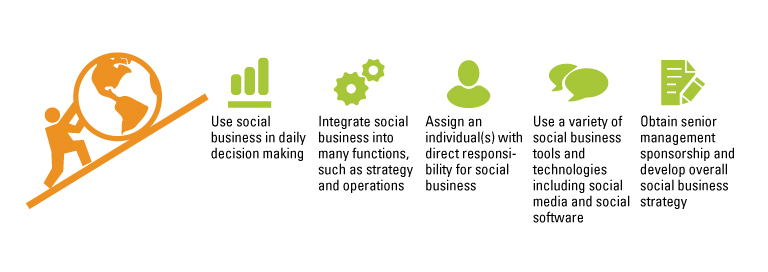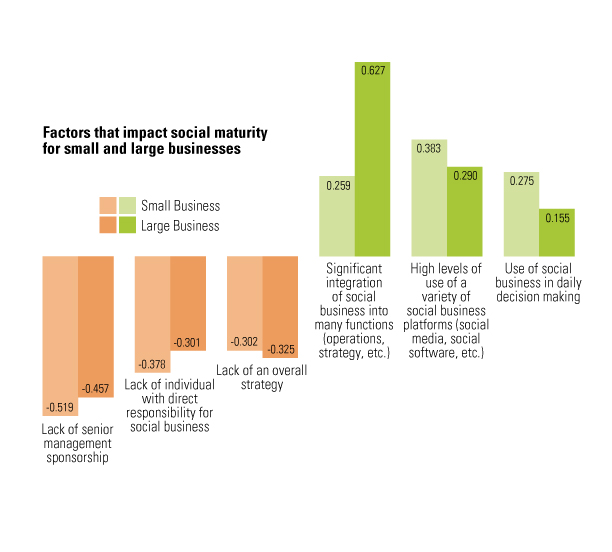Snapshot: The State of Play
Despite the immediacy of the opportunity, the socially connected enterprise is emerging slowly. To assess that emergence, we asked respondents to evaluate their organization’s social business maturity along a scale of 1 to 10. Specifically, we asked: “Imagine an organization transformed by social tools that drive collaboration and information sharing across the enterprise and integrate social data into operational processes. How close is your company to achieving this ideal?” (See Figure 3.)
More than half of the respondents — 52% — rated their organization at 3 or less. A scant 17% assessed their company at 7 and above. Moreover, in many organizations, social business is still an experiment: 44% of respondents indicated they are implementing an initiative in their departments, but more than half of these are pilot projects.
Dion Hinchcliffe of the Dachis Group describes “a trough of disillusionment” that businesses encountered with social media.He argues that social media was not originally intended for business use. It was created primarily by consumer companies looking for ways to better connect people. As a result, social media tools lacked the security, compliance and control capabilities businesses need. But the landscape is starting to change. “These requirements have made their way into the tools only in the past few years,” he says. “We are now at the point where the tools are starting to meet business needs.”
The point is well taken. However, our study discovered that there are statistically significant markers of success — and barriers to it. These markers correlate with social business maturity and go well beyond the business readiness of any technology. (See Figure 4.)
For example, companies that are moving closer to the ideal of a socially networked organization share distinct characteristics. One significant characteristic is the integration of social into many business functions, including marketing, sales, IT and customer service. At Enterasys Networks, a mid-size network infrastructure and security company, 100% of employees have access to Salesforce.com’s Chatter product, and 80% use it to collaborate, share, and work across organizational boundaries and functions.
For example, companies that are moving closer to the ideal of a socially networked organization share distinct characteristics. One significant characteristic is the integration of social into many business functions, including marketing, sales, IT and customer service. At Enterasys Networks, a mid-size network infrastructure and security company, 100% of employees have access to Salesforce.com’s Chatter product, and 80% use it to collaborate, share, and work across organizational boundaries and functions.
Companies further along the maturity path also use social media technologies in daily decision making. The Cisco Learning Network, for example, is integrated with the company’s transaction systems, and the marketing team at Learning@Cisco uses data analytics tools to spot major trends and address customer requirements. More socially mature companies also avail themselves of a variety of social business tools and technologies, including media, software, data and technology-based networks.
Companies at the low end of the maturity spectrum share common hurdles. Lack of senior management sponsorship is significant. In businesses where support from senior leadership was lacking, respondents typically assessed their organization’s maturity a half point lower.
Lack of an overall strategy was also an influential barrier to progress. On average, feeling that their organizations lacked a clear social business strategy knocked nearly a third of a point off respondents’ assessment of the company’s maturity.
Taken together, the positive impact of management sponsorship and need for a clear strategy provide company leadership straightforward guidance on how to move the social needle. “It is incumbent on leaders to be intentional about social media and have a strategy for what they want to achieve with it,” says Michael Slind, co-author of Talk, Inc.: The Power of Organizational Conversation.
Divergent Paths to Social MaturityThere is no single path that leads to social business maturity. Company size plays a key role in determining the purpose of social business as well as how it matures. Among small companies (less than $250 million annual revenue), more socially mature organizations focus their social efforts on providing customer support, managing projects and accelerating innovation. According to our research, respondents from small companies that used social for any of these purposes rated their companies’ social maturity nearly half a point higher (on a 10-point maturity scale) than those that didn’t.
By contrast, larger organizations with more mature social capabilities leverage the entire analytical social business life cycle — generating social data, monitoring collection and integrating it into systems and processes. “The potential of social analytics is enormous,” says Sheila Jordan, Cisco’s senior vice president of communication and collaboration IT. “We capture and summarize major trends and communicate them to everyone from executives to engineers working on products in real time.”
More-mature large companies are also more likely than their less-mature counterparts to have a business case for social efforts. In fact, lack of a business case detracts considerably from the assessment of social business maturity at large companies. It cuts a half point. (See Figure 5.)
Dell’s Path to Social Maturity
Dell Inc. is a prime example of how companies can capitalize on social business opportunities and reach social business maturity over time. At Dell, social business began simply enough — a corporate blog. Seven years later, social is ingrained in its operations, and Dell now provides social business services to other companies. (See Figure 6.)
As a company approaching social business maturity, unique aspects of Dell’s social business program stand out:
- Dell’s social activity extends beyond the marketing function. The company leverages social media to improve customer engagement, provide enhanced customer service and build products based on customer input through the company’s well-known IdeaStorm program started in 2007. The company extended IdeaStorm internally later in 2007, to help enhance productivity as well. IdeaStorm has led to the implementation of more than 500 new product ideas.
- Dell leverages the entire analytical social business life cycle — not only generating data, but monitoring and using it to make decisions. Building on the success of IdeaStorm, Dell realized that it needed to listen more carefully to the conversations among its customers in social media. In 2010, the company established a social media command center that helps it monitor online conversations in real-time and more deeply understand customer needs.
- In 2012, Dell enhanced its listening program, implementing social technologies that grab, sort and analyze vast amounts of digital conversations about Dell, its competitors and specific technologies. Applying natural language processing to more than 25,000 online mentions of Dell each day, the company translates that data into marketing strategy and customer service offerings.
- Michael Dell’s leadership has contributed to the company’s social business progress from the early stages to the present. According to Dell’s director of social media, Richard Margetic, “without Michael’s leadership, there’s no way we would have been able to become a social business.” Simply put, he says, “we wouldn’t have been able to get anything done.”
- The company’s social business strategies and direction are centralized, while its social media functions and teams are distributed and embedded across various functional units at Dell. In order to ensure the company is pursuing an agreed-upon direction and consistent strategy, the directors of each of these social teams meet weekly to work together cross-functionally. Richard Margetic brings together these directors and oversees the execution of the company’s social strategies, governance and policies.
Today, Dell Inc. has even set up its own consulting division to teach other companies how to be an effective social enterprise. Its Social Media Services Group trains other companies to develop better real-time customer insights, engage their audience and better understand their customers in the market. Not only does Dell show other companies what it has done, it also provides training for their staff on how to use and create these processes for themselves.
Page 1. Social Business: Shifting Out of First Gear
Page 1. Social Business: Shifting Out of First Gear




No comments:
Post a Comment